Research Project: Wi-Fi Connectivity's Impact on Tourism Experience
VerifiedAdded on 2024/06/07
|39
|6486
|261
Report
AI Summary
This research report investigates the impact of Wi-Fi connectivity on visitor experiences within the travel and tourism industry. It begins by highlighting the increasing importance of Wi-Fi access for modern travelers, driven by smartphone usage and the desire for constant connectivity. The study explores how Wi-Fi affects various aspects of the visitor experience, including accessing information, sharing experiences on social media, and overall satisfaction. The research employs both primary data collection through online questionnaires distributed to UKCBC students and secondary data analysis of academic literature, journals, and online articles. Ethical considerations are addressed, ensuring privacy and informed consent. The findings aim to provide insights into how travel and tourism businesses can leverage Wi-Fi connectivity to enhance customer experiences and improve operational efficiencies, while also acknowledging the limitations of the research and suggesting areas for future exploration.
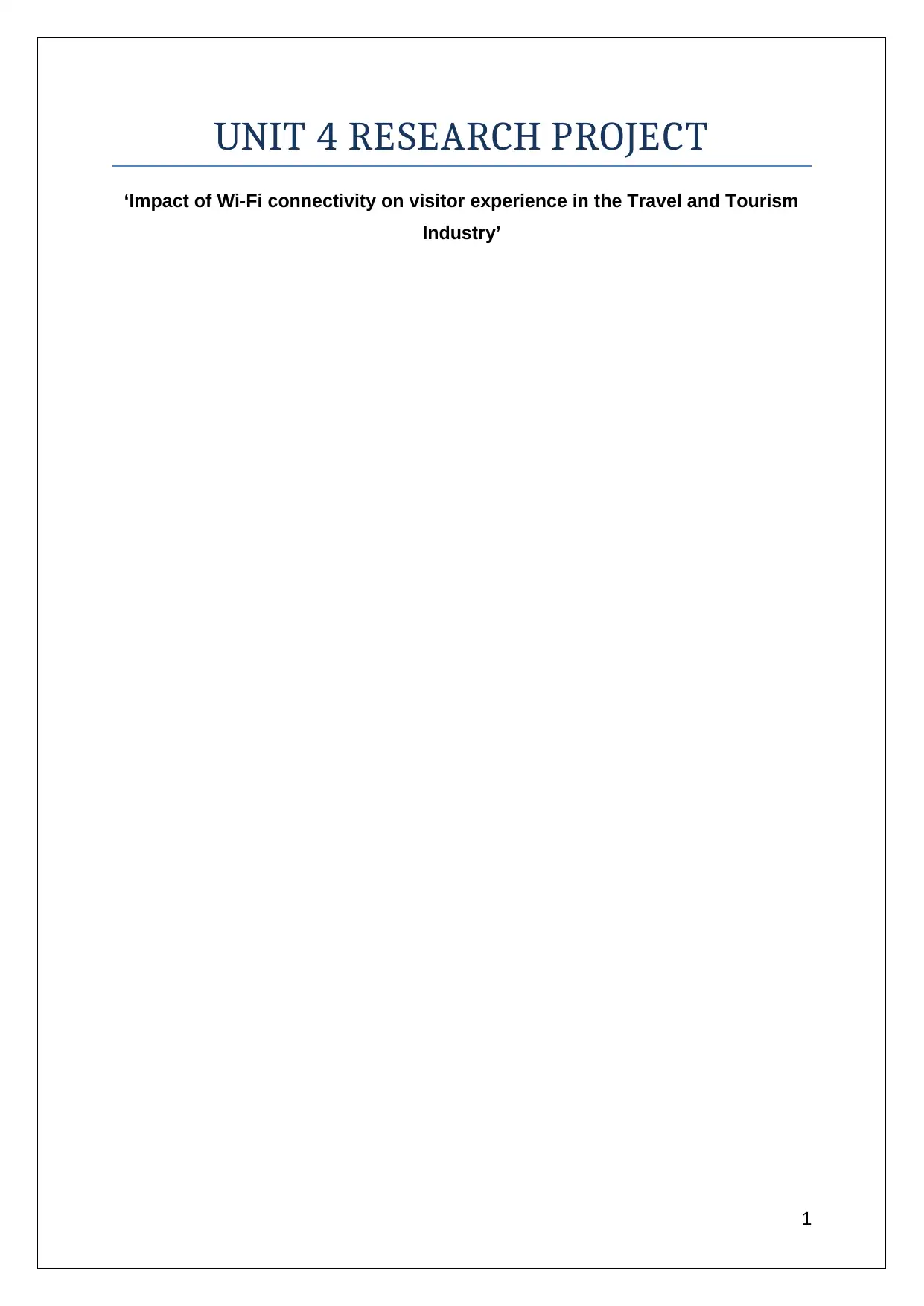
UNIT 4 RESEARCH PROJECT
‘Impact of Wi-Fi connectivity on visitor experience in the Travel and Tourism
Industry’
1
‘Impact of Wi-Fi connectivity on visitor experience in the Travel and Tourism
Industry’
1
Paraphrase This Document
Need a fresh take? Get an instant paraphrase of this document with our AI Paraphraser
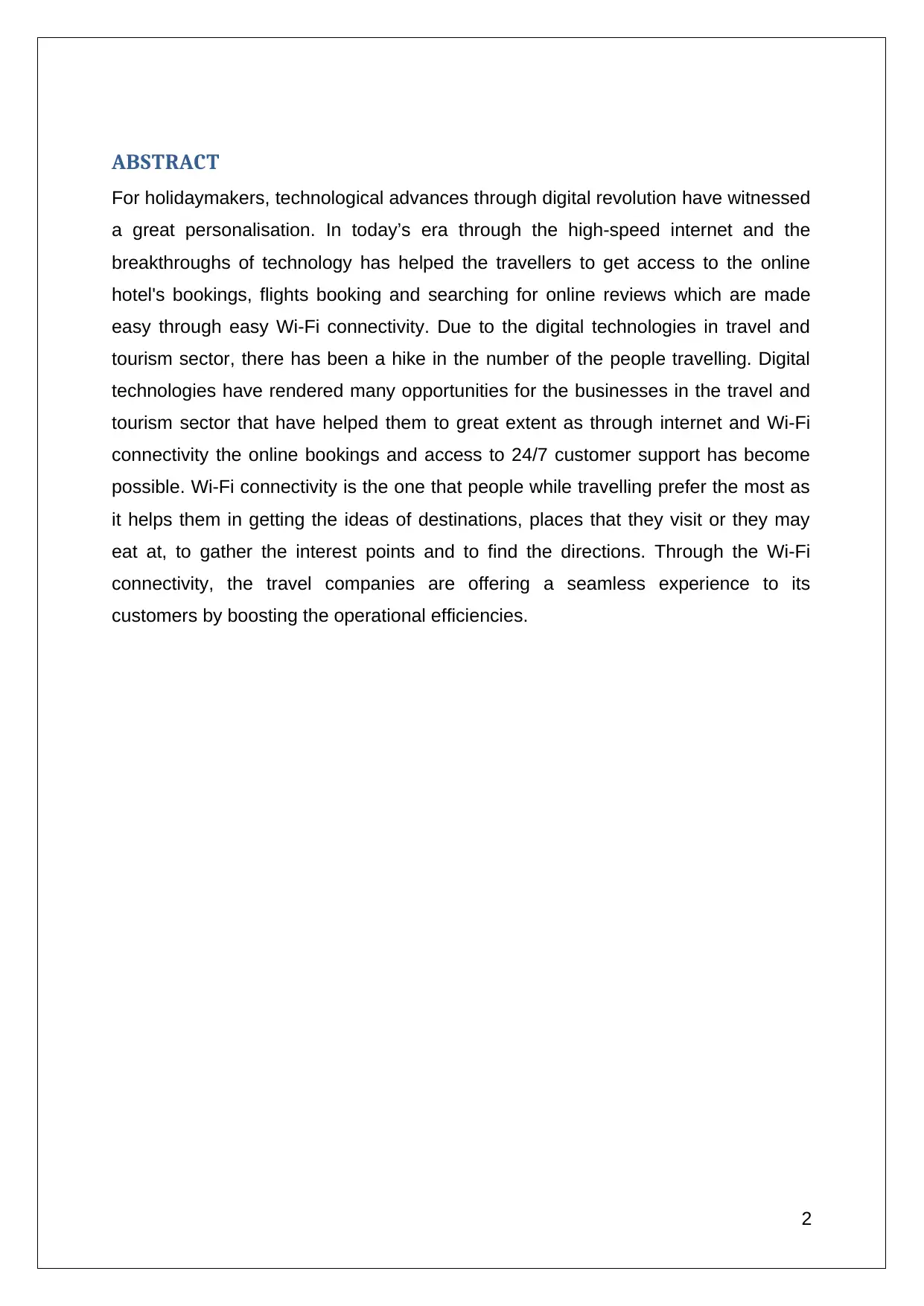
ABSTRACT
For holidaymakers, technological advances through digital revolution have witnessed
a great personalisation. In today’s era through the high-speed internet and the
breakthroughs of technology has helped the travellers to get access to the online
hotel's bookings, flights booking and searching for online reviews which are made
easy through easy Wi-Fi connectivity. Due to the digital technologies in travel and
tourism sector, there has been a hike in the number of the people travelling. Digital
technologies have rendered many opportunities for the businesses in the travel and
tourism sector that have helped them to great extent as through internet and Wi-Fi
connectivity the online bookings and access to 24/7 customer support has become
possible. Wi-Fi connectivity is the one that people while travelling prefer the most as
it helps them in getting the ideas of destinations, places that they visit or they may
eat at, to gather the interest points and to find the directions. Through the Wi-Fi
connectivity, the travel companies are offering a seamless experience to its
customers by boosting the operational efficiencies.
2
For holidaymakers, technological advances through digital revolution have witnessed
a great personalisation. In today’s era through the high-speed internet and the
breakthroughs of technology has helped the travellers to get access to the online
hotel's bookings, flights booking and searching for online reviews which are made
easy through easy Wi-Fi connectivity. Due to the digital technologies in travel and
tourism sector, there has been a hike in the number of the people travelling. Digital
technologies have rendered many opportunities for the businesses in the travel and
tourism sector that have helped them to great extent as through internet and Wi-Fi
connectivity the online bookings and access to 24/7 customer support has become
possible. Wi-Fi connectivity is the one that people while travelling prefer the most as
it helps them in getting the ideas of destinations, places that they visit or they may
eat at, to gather the interest points and to find the directions. Through the Wi-Fi
connectivity, the travel companies are offering a seamless experience to its
customers by boosting the operational efficiencies.
2
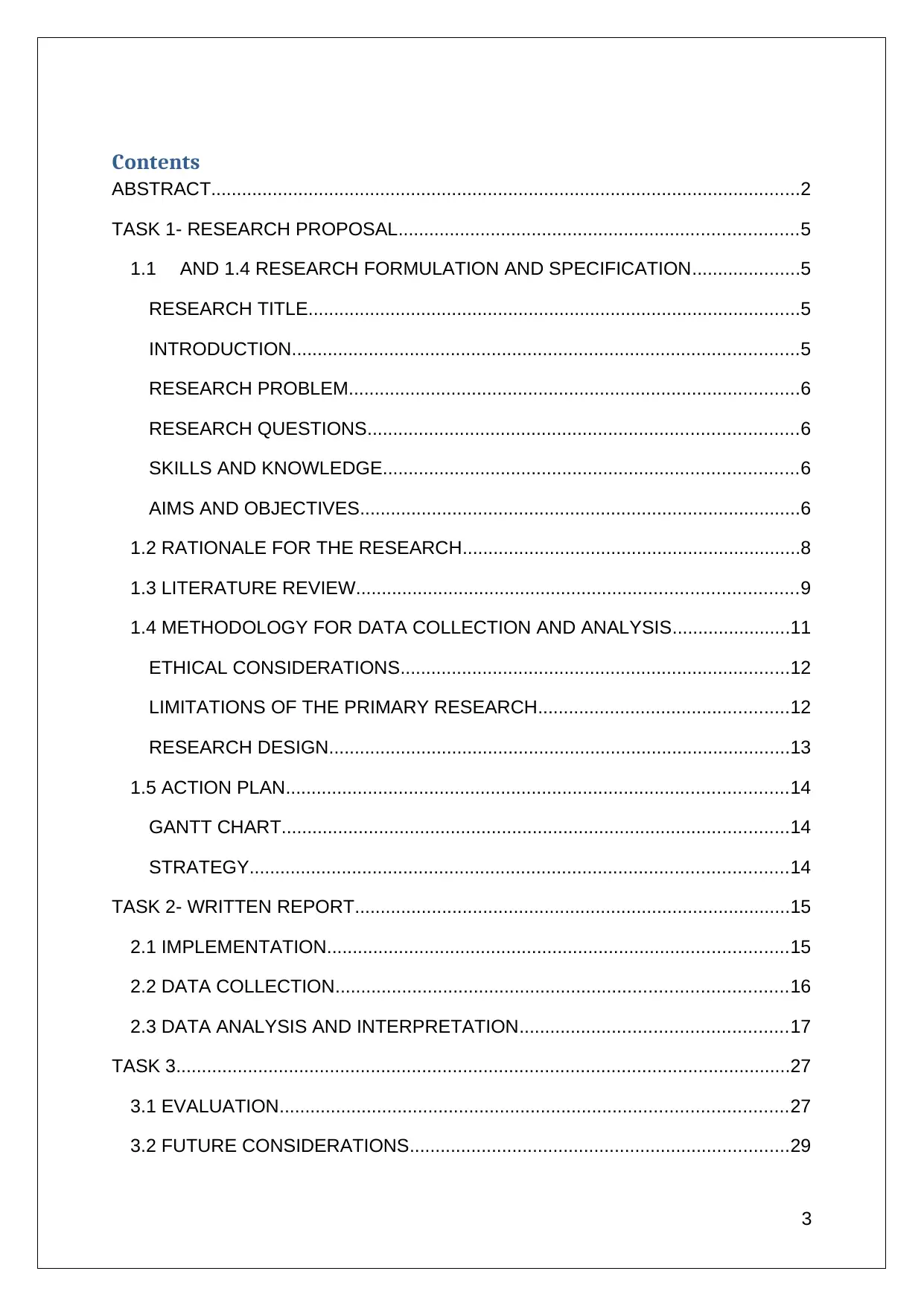
Contents
ABSTRACT...................................................................................................................2
TASK 1- RESEARCH PROPOSAL..............................................................................5
1.1 AND 1.4 RESEARCH FORMULATION AND SPECIFICATION.....................5
RESEARCH TITLE................................................................................................5
INTRODUCTION...................................................................................................5
RESEARCH PROBLEM........................................................................................6
RESEARCH QUESTIONS....................................................................................6
SKILLS AND KNOWLEDGE.................................................................................6
AIMS AND OBJECTIVES......................................................................................6
1.2 RATIONALE FOR THE RESEARCH..................................................................8
1.3 LITERATURE REVIEW......................................................................................9
1.4 METHODOLOGY FOR DATA COLLECTION AND ANALYSIS.......................11
ETHICAL CONSIDERATIONS............................................................................12
LIMITATIONS OF THE PRIMARY RESEARCH.................................................12
RESEARCH DESIGN..........................................................................................13
1.5 ACTION PLAN..................................................................................................14
GANTT CHART...................................................................................................14
STRATEGY.........................................................................................................14
TASK 2- WRITTEN REPORT.....................................................................................15
2.1 IMPLEMENTATION..........................................................................................15
2.2 DATA COLLECTION........................................................................................16
2.3 DATA ANALYSIS AND INTERPRETATION....................................................17
TASK 3........................................................................................................................27
3.1 EVALUATION...................................................................................................27
3.2 FUTURE CONSIDERATIONS..........................................................................29
3
ABSTRACT...................................................................................................................2
TASK 1- RESEARCH PROPOSAL..............................................................................5
1.1 AND 1.4 RESEARCH FORMULATION AND SPECIFICATION.....................5
RESEARCH TITLE................................................................................................5
INTRODUCTION...................................................................................................5
RESEARCH PROBLEM........................................................................................6
RESEARCH QUESTIONS....................................................................................6
SKILLS AND KNOWLEDGE.................................................................................6
AIMS AND OBJECTIVES......................................................................................6
1.2 RATIONALE FOR THE RESEARCH..................................................................8
1.3 LITERATURE REVIEW......................................................................................9
1.4 METHODOLOGY FOR DATA COLLECTION AND ANALYSIS.......................11
ETHICAL CONSIDERATIONS............................................................................12
LIMITATIONS OF THE PRIMARY RESEARCH.................................................12
RESEARCH DESIGN..........................................................................................13
1.5 ACTION PLAN..................................................................................................14
GANTT CHART...................................................................................................14
STRATEGY.........................................................................................................14
TASK 2- WRITTEN REPORT.....................................................................................15
2.1 IMPLEMENTATION..........................................................................................15
2.2 DATA COLLECTION........................................................................................16
2.3 DATA ANALYSIS AND INTERPRETATION....................................................17
TASK 3........................................................................................................................27
3.1 EVALUATION...................................................................................................27
3.2 FUTURE CONSIDERATIONS..........................................................................29
3
⊘ This is a preview!⊘
Do you want full access?
Subscribe today to unlock all pages.

Trusted by 1+ million students worldwide
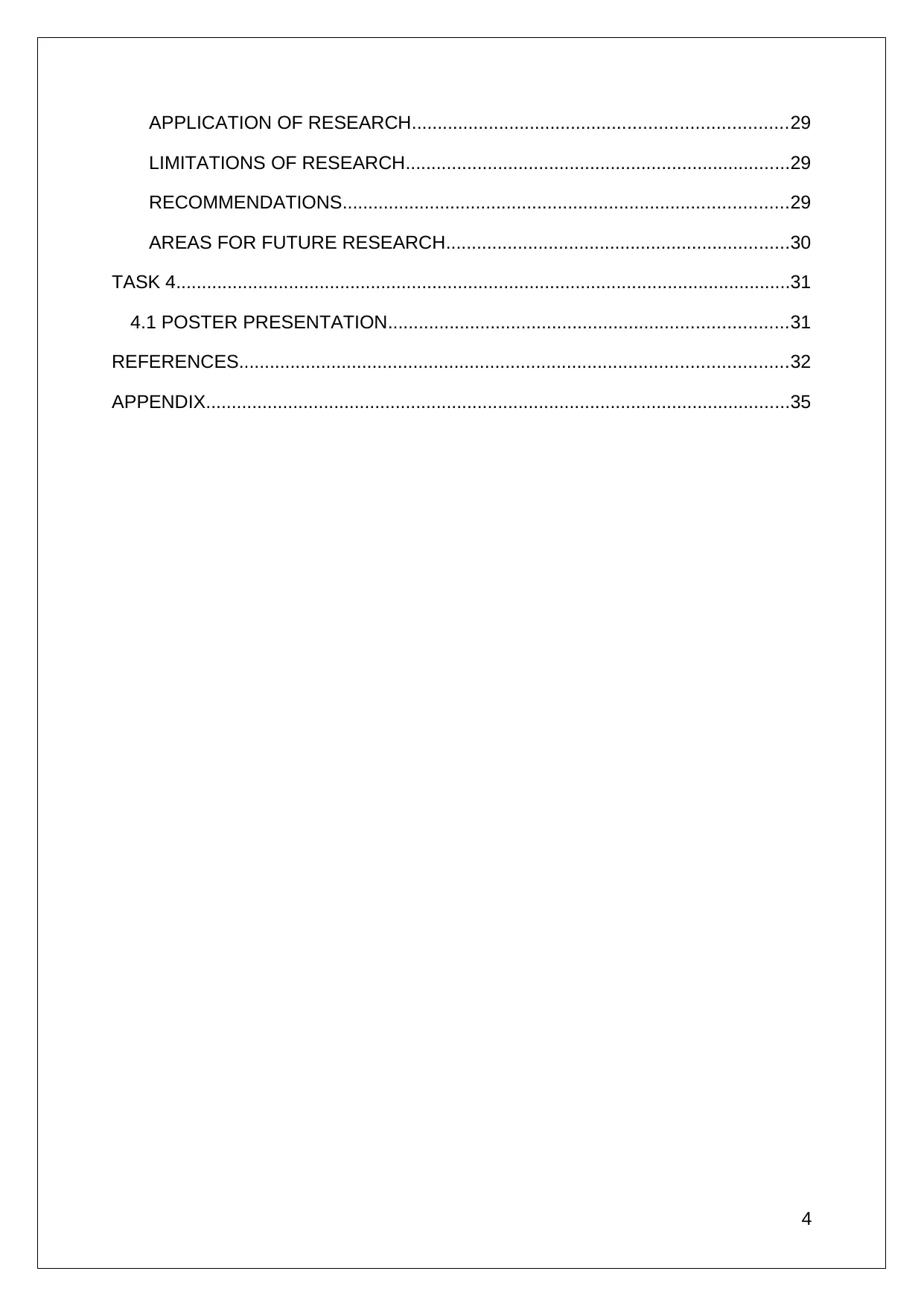
APPLICATION OF RESEARCH.........................................................................29
LIMITATIONS OF RESEARCH...........................................................................29
RECOMMENDATIONS.......................................................................................29
AREAS FOR FUTURE RESEARCH...................................................................30
TASK 4........................................................................................................................31
4.1 POSTER PRESENTATION..............................................................................31
REFERENCES...........................................................................................................32
APPENDIX..................................................................................................................35
4
LIMITATIONS OF RESEARCH...........................................................................29
RECOMMENDATIONS.......................................................................................29
AREAS FOR FUTURE RESEARCH...................................................................30
TASK 4........................................................................................................................31
4.1 POSTER PRESENTATION..............................................................................31
REFERENCES...........................................................................................................32
APPENDIX..................................................................................................................35
4
Paraphrase This Document
Need a fresh take? Get an instant paraphrase of this document with our AI Paraphraser
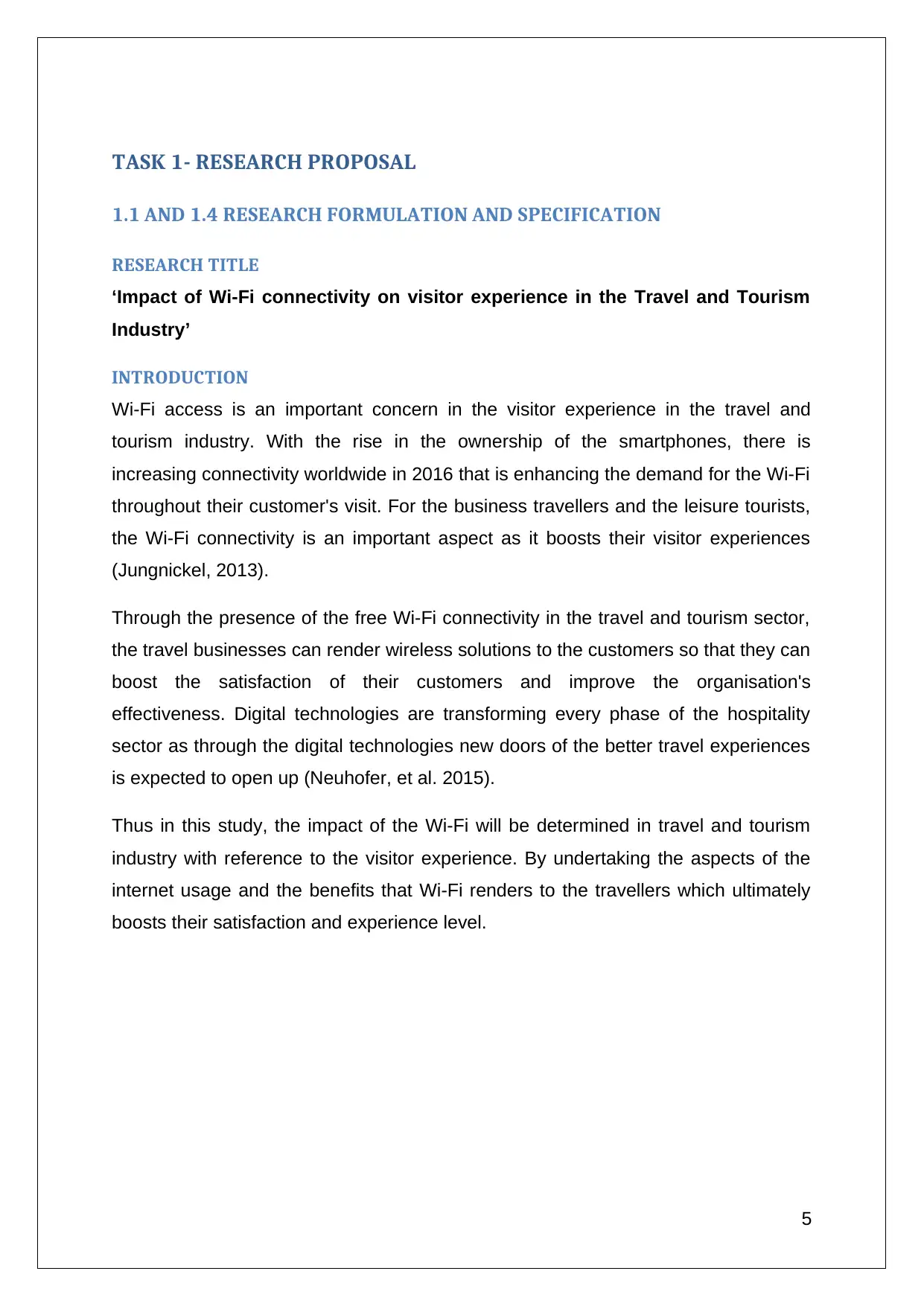
TASK 1- RESEARCH PROPOSAL
1.1 AND 1.4 RESEARCH FORMULATION AND SPECIFICATION
RESEARCH TITLE
‘Impact of Wi-Fi connectivity on visitor experience in the Travel and Tourism
Industry’
INTRODUCTION
Wi-Fi access is an important concern in the visitor experience in the travel and
tourism industry. With the rise in the ownership of the smartphones, there is
increasing connectivity worldwide in 2016 that is enhancing the demand for the Wi-Fi
throughout their customer's visit. For the business travellers and the leisure tourists,
the Wi-Fi connectivity is an important aspect as it boosts their visitor experiences
(Jungnickel, 2013).
Through the presence of the free Wi-Fi connectivity in the travel and tourism sector,
the travel businesses can render wireless solutions to the customers so that they can
boost the satisfaction of their customers and improve the organisation's
effectiveness. Digital technologies are transforming every phase of the hospitality
sector as through the digital technologies new doors of the better travel experiences
is expected to open up (Neuhofer, et al. 2015).
Thus in this study, the impact of the Wi-Fi will be determined in travel and tourism
industry with reference to the visitor experience. By undertaking the aspects of the
internet usage and the benefits that Wi-Fi renders to the travellers which ultimately
boosts their satisfaction and experience level.
5
1.1 AND 1.4 RESEARCH FORMULATION AND SPECIFICATION
RESEARCH TITLE
‘Impact of Wi-Fi connectivity on visitor experience in the Travel and Tourism
Industry’
INTRODUCTION
Wi-Fi access is an important concern in the visitor experience in the travel and
tourism industry. With the rise in the ownership of the smartphones, there is
increasing connectivity worldwide in 2016 that is enhancing the demand for the Wi-Fi
throughout their customer's visit. For the business travellers and the leisure tourists,
the Wi-Fi connectivity is an important aspect as it boosts their visitor experiences
(Jungnickel, 2013).
Through the presence of the free Wi-Fi connectivity in the travel and tourism sector,
the travel businesses can render wireless solutions to the customers so that they can
boost the satisfaction of their customers and improve the organisation's
effectiveness. Digital technologies are transforming every phase of the hospitality
sector as through the digital technologies new doors of the better travel experiences
is expected to open up (Neuhofer, et al. 2015).
Thus in this study, the impact of the Wi-Fi will be determined in travel and tourism
industry with reference to the visitor experience. By undertaking the aspects of the
internet usage and the benefits that Wi-Fi renders to the travellers which ultimately
boosts their satisfaction and experience level.
5
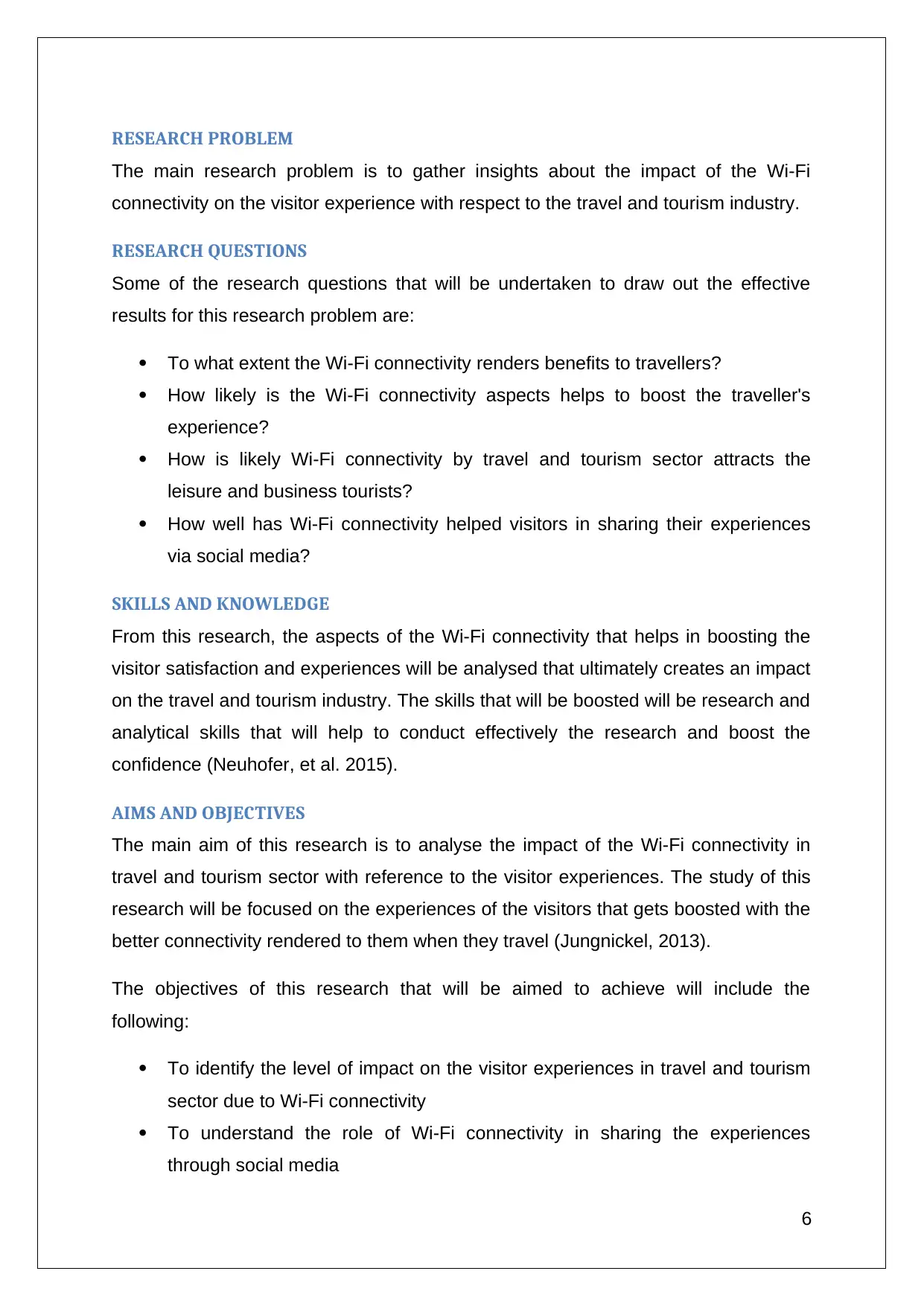
RESEARCH PROBLEM
The main research problem is to gather insights about the impact of the Wi-Fi
connectivity on the visitor experience with respect to the travel and tourism industry.
RESEARCH QUESTIONS
Some of the research questions that will be undertaken to draw out the effective
results for this research problem are:
To what extent the Wi-Fi connectivity renders benefits to travellers?
How likely is the Wi-Fi connectivity aspects helps to boost the traveller's
experience?
How is likely Wi-Fi connectivity by travel and tourism sector attracts the
leisure and business tourists?
How well has Wi-Fi connectivity helped visitors in sharing their experiences
via social media?
SKILLS AND KNOWLEDGE
From this research, the aspects of the Wi-Fi connectivity that helps in boosting the
visitor satisfaction and experiences will be analysed that ultimately creates an impact
on the travel and tourism industry. The skills that will be boosted will be research and
analytical skills that will help to conduct effectively the research and boost the
confidence (Neuhofer, et al. 2015).
AIMS AND OBJECTIVES
The main aim of this research is to analyse the impact of the Wi-Fi connectivity in
travel and tourism sector with reference to the visitor experiences. The study of this
research will be focused on the experiences of the visitors that gets boosted with the
better connectivity rendered to them when they travel (Jungnickel, 2013).
The objectives of this research that will be aimed to achieve will include the
following:
To identify the level of impact on the visitor experiences in travel and tourism
sector due to Wi-Fi connectivity
To understand the role of Wi-Fi connectivity in sharing the experiences
through social media
6
The main research problem is to gather insights about the impact of the Wi-Fi
connectivity on the visitor experience with respect to the travel and tourism industry.
RESEARCH QUESTIONS
Some of the research questions that will be undertaken to draw out the effective
results for this research problem are:
To what extent the Wi-Fi connectivity renders benefits to travellers?
How likely is the Wi-Fi connectivity aspects helps to boost the traveller's
experience?
How is likely Wi-Fi connectivity by travel and tourism sector attracts the
leisure and business tourists?
How well has Wi-Fi connectivity helped visitors in sharing their experiences
via social media?
SKILLS AND KNOWLEDGE
From this research, the aspects of the Wi-Fi connectivity that helps in boosting the
visitor satisfaction and experiences will be analysed that ultimately creates an impact
on the travel and tourism industry. The skills that will be boosted will be research and
analytical skills that will help to conduct effectively the research and boost the
confidence (Neuhofer, et al. 2015).
AIMS AND OBJECTIVES
The main aim of this research is to analyse the impact of the Wi-Fi connectivity in
travel and tourism sector with reference to the visitor experiences. The study of this
research will be focused on the experiences of the visitors that gets boosted with the
better connectivity rendered to them when they travel (Jungnickel, 2013).
The objectives of this research that will be aimed to achieve will include the
following:
To identify the level of impact on the visitor experiences in travel and tourism
sector due to Wi-Fi connectivity
To understand the role of Wi-Fi connectivity in sharing the experiences
through social media
6
⊘ This is a preview!⊘
Do you want full access?
Subscribe today to unlock all pages.

Trusted by 1+ million students worldwide
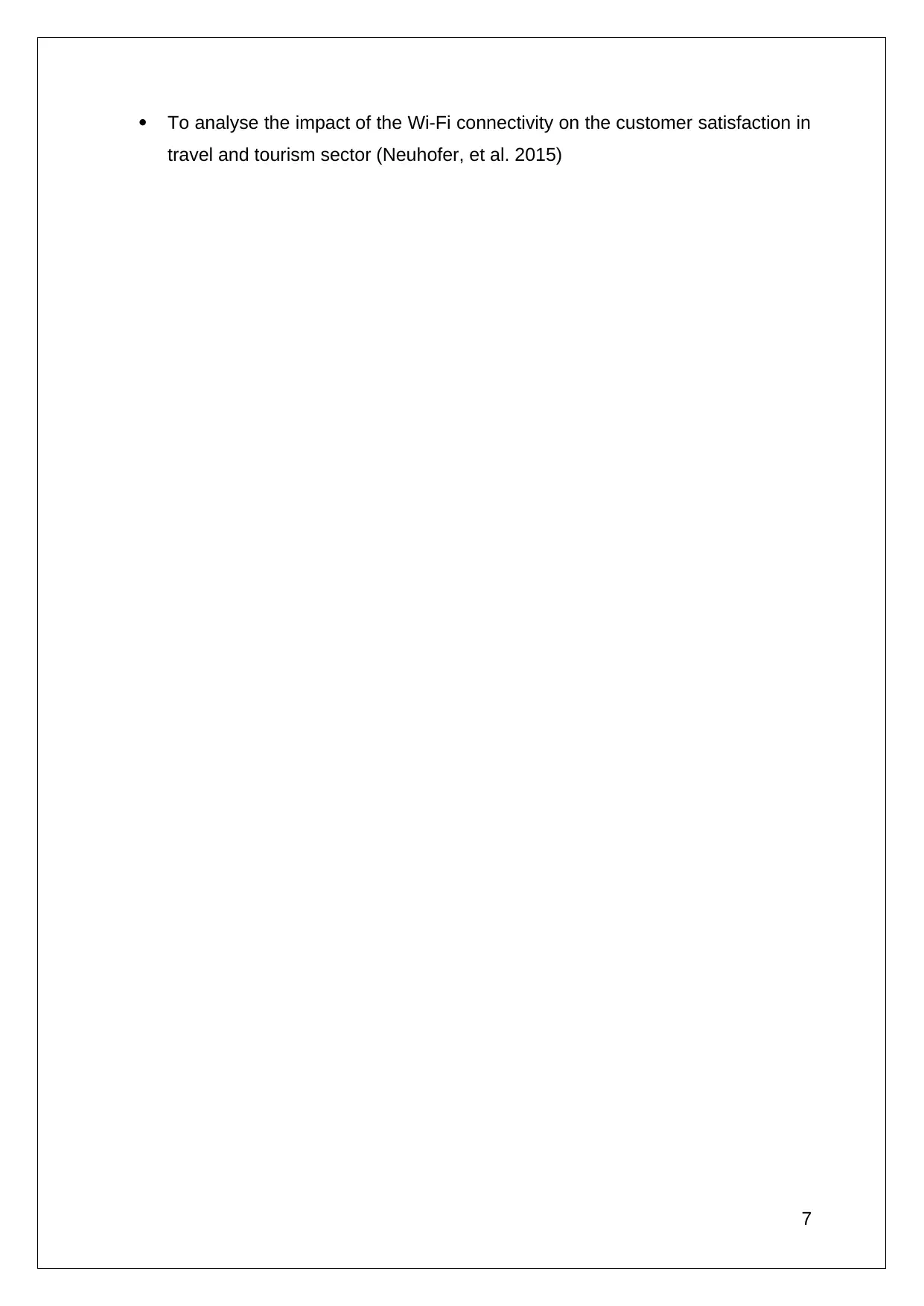
To analyse the impact of the Wi-Fi connectivity on the customer satisfaction in
travel and tourism sector (Neuhofer, et al. 2015)
7
travel and tourism sector (Neuhofer, et al. 2015)
7
Paraphrase This Document
Need a fresh take? Get an instant paraphrase of this document with our AI Paraphraser
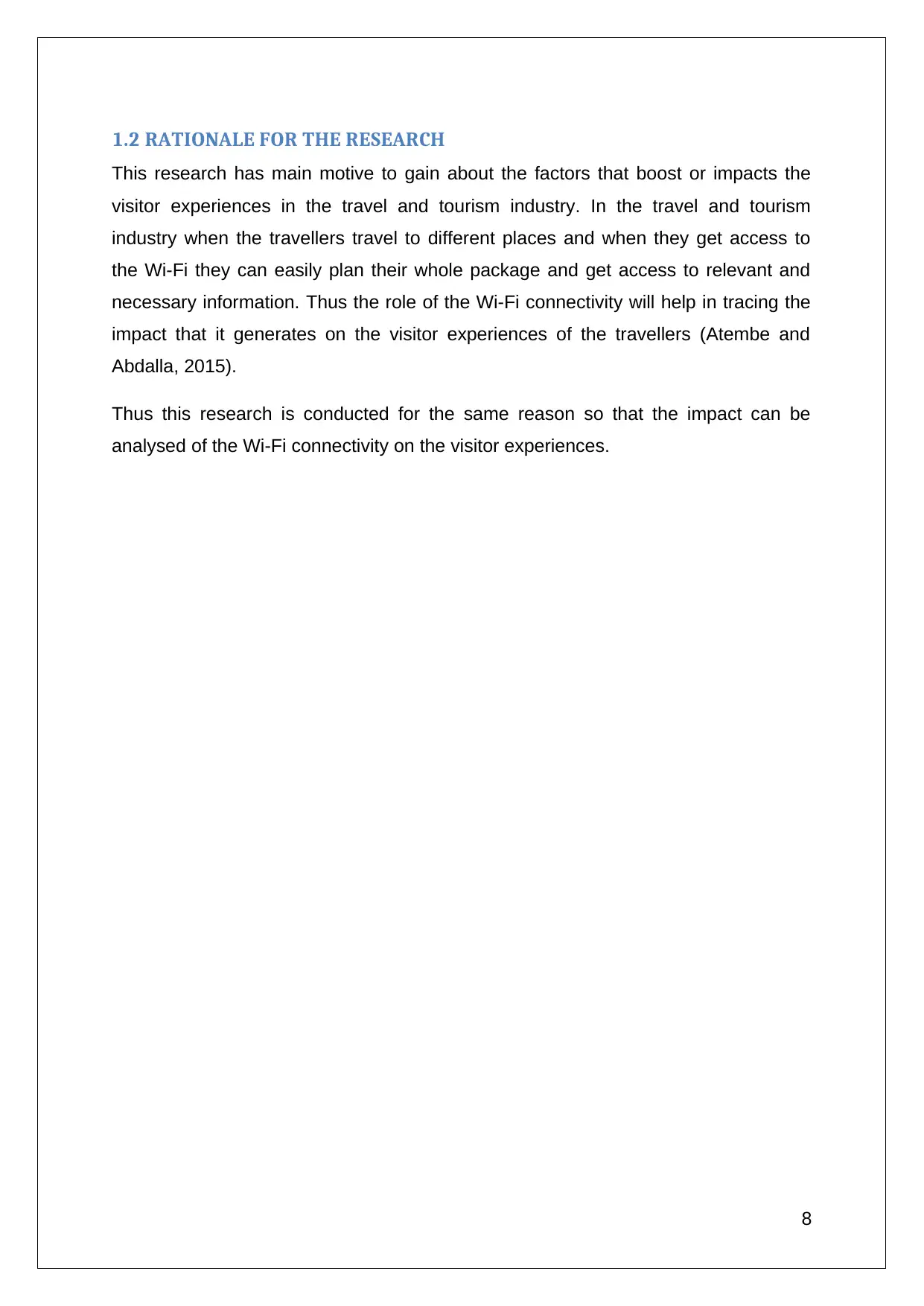
1.2 RATIONALE FOR THE RESEARCH
This research has main motive to gain about the factors that boost or impacts the
visitor experiences in the travel and tourism industry. In the travel and tourism
industry when the travellers travel to different places and when they get access to
the Wi-Fi they can easily plan their whole package and get access to relevant and
necessary information. Thus the role of the Wi-Fi connectivity will help in tracing the
impact that it generates on the visitor experiences of the travellers (Atembe and
Abdalla, 2015).
Thus this research is conducted for the same reason so that the impact can be
analysed of the Wi-Fi connectivity on the visitor experiences.
8
This research has main motive to gain about the factors that boost or impacts the
visitor experiences in the travel and tourism industry. In the travel and tourism
industry when the travellers travel to different places and when they get access to
the Wi-Fi they can easily plan their whole package and get access to relevant and
necessary information. Thus the role of the Wi-Fi connectivity will help in tracing the
impact that it generates on the visitor experiences of the travellers (Atembe and
Abdalla, 2015).
Thus this research is conducted for the same reason so that the impact can be
analysed of the Wi-Fi connectivity on the visitor experiences.
8
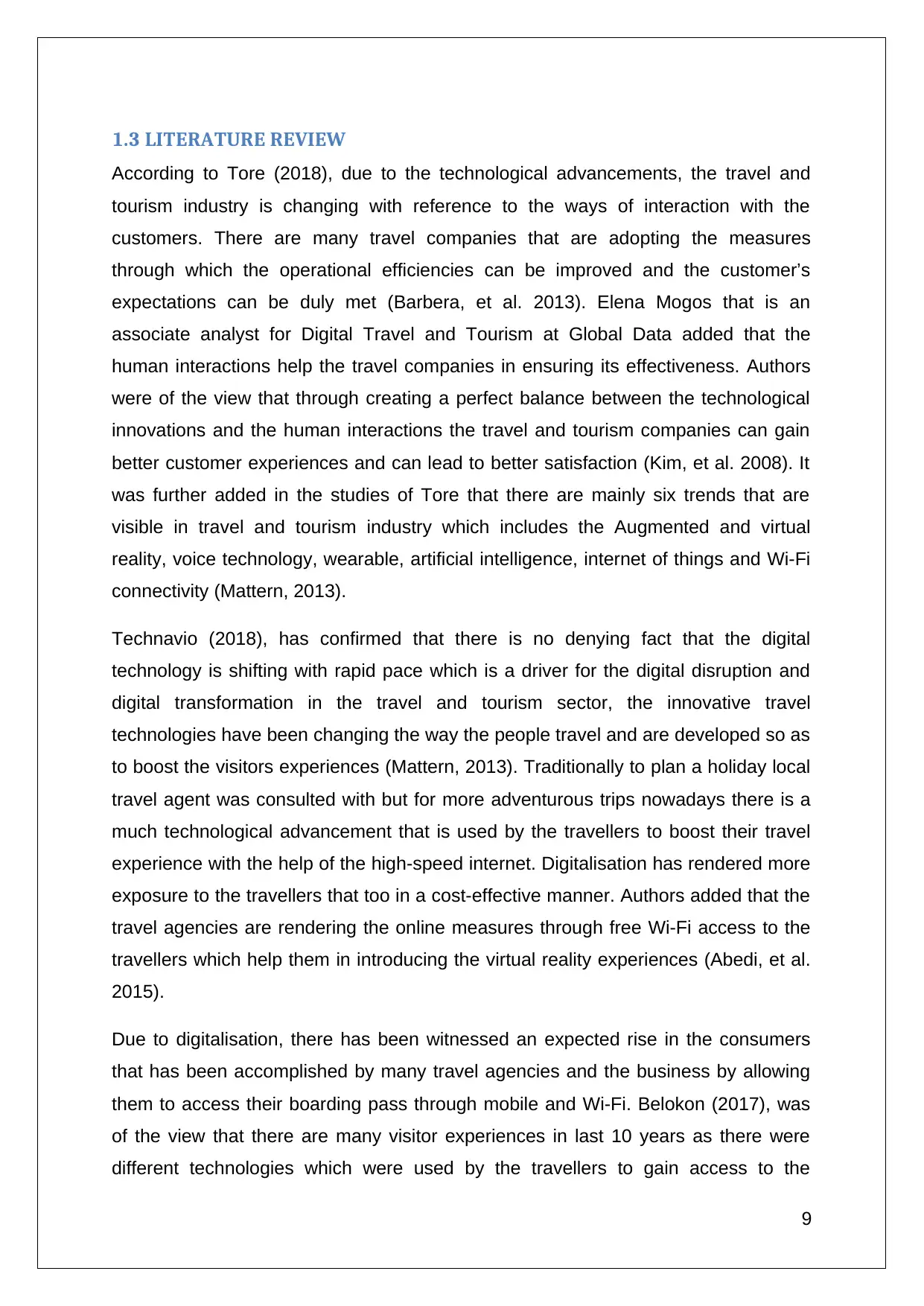
1.3 LITERATURE REVIEW
According to Tore (2018), due to the technological advancements, the travel and
tourism industry is changing with reference to the ways of interaction with the
customers. There are many travel companies that are adopting the measures
through which the operational efficiencies can be improved and the customer’s
expectations can be duly met (Barbera, et al. 2013). Elena Mogos that is an
associate analyst for Digital Travel and Tourism at Global Data added that the
human interactions help the travel companies in ensuring its effectiveness. Authors
were of the view that through creating a perfect balance between the technological
innovations and the human interactions the travel and tourism companies can gain
better customer experiences and can lead to better satisfaction (Kim, et al. 2008). It
was further added in the studies of Tore that there are mainly six trends that are
visible in travel and tourism industry which includes the Augmented and virtual
reality, voice technology, wearable, artificial intelligence, internet of things and Wi-Fi
connectivity (Mattern, 2013).
Technavio (2018), has confirmed that there is no denying fact that the digital
technology is shifting with rapid pace which is a driver for the digital disruption and
digital transformation in the travel and tourism sector, the innovative travel
technologies have been changing the way the people travel and are developed so as
to boost the visitors experiences (Mattern, 2013). Traditionally to plan a holiday local
travel agent was consulted with but for more adventurous trips nowadays there is a
much technological advancement that is used by the travellers to boost their travel
experience with the help of the high-speed internet. Digitalisation has rendered more
exposure to the travellers that too in a cost-effective manner. Authors added that the
travel agencies are rendering the online measures through free Wi-Fi access to the
travellers which help them in introducing the virtual reality experiences (Abedi, et al.
2015).
Due to digitalisation, there has been witnessed an expected rise in the consumers
that has been accomplished by many travel agencies and the business by allowing
them to access their boarding pass through mobile and Wi-Fi. Belokon (2017), was
of the view that there are many visitor experiences in last 10 years as there were
different technologies which were used by the travellers to gain access to the
9
According to Tore (2018), due to the technological advancements, the travel and
tourism industry is changing with reference to the ways of interaction with the
customers. There are many travel companies that are adopting the measures
through which the operational efficiencies can be improved and the customer’s
expectations can be duly met (Barbera, et al. 2013). Elena Mogos that is an
associate analyst for Digital Travel and Tourism at Global Data added that the
human interactions help the travel companies in ensuring its effectiveness. Authors
were of the view that through creating a perfect balance between the technological
innovations and the human interactions the travel and tourism companies can gain
better customer experiences and can lead to better satisfaction (Kim, et al. 2008). It
was further added in the studies of Tore that there are mainly six trends that are
visible in travel and tourism industry which includes the Augmented and virtual
reality, voice technology, wearable, artificial intelligence, internet of things and Wi-Fi
connectivity (Mattern, 2013).
Technavio (2018), has confirmed that there is no denying fact that the digital
technology is shifting with rapid pace which is a driver for the digital disruption and
digital transformation in the travel and tourism sector, the innovative travel
technologies have been changing the way the people travel and are developed so as
to boost the visitors experiences (Mattern, 2013). Traditionally to plan a holiday local
travel agent was consulted with but for more adventurous trips nowadays there is a
much technological advancement that is used by the travellers to boost their travel
experience with the help of the high-speed internet. Digitalisation has rendered more
exposure to the travellers that too in a cost-effective manner. Authors added that the
travel agencies are rendering the online measures through free Wi-Fi access to the
travellers which help them in introducing the virtual reality experiences (Abedi, et al.
2015).
Due to digitalisation, there has been witnessed an expected rise in the consumers
that has been accomplished by many travel agencies and the business by allowing
them to access their boarding pass through mobile and Wi-Fi. Belokon (2017), was
of the view that there are many visitor experiences in last 10 years as there were
different technologies which were used by the travellers to gain access to the
9
⊘ This is a preview!⊘
Do you want full access?
Subscribe today to unlock all pages.

Trusted by 1+ million students worldwide
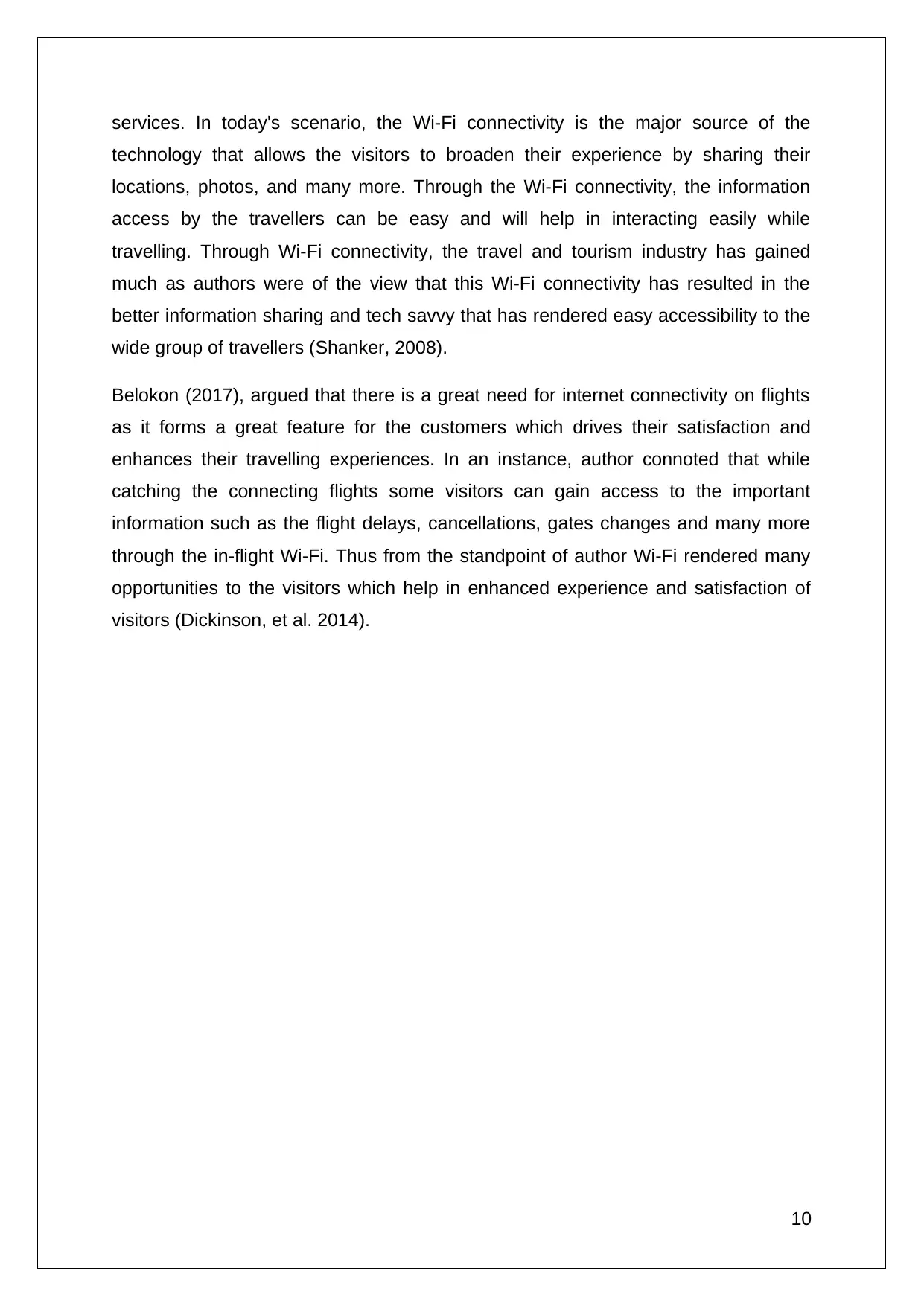
services. In today's scenario, the Wi-Fi connectivity is the major source of the
technology that allows the visitors to broaden their experience by sharing their
locations, photos, and many more. Through the Wi-Fi connectivity, the information
access by the travellers can be easy and will help in interacting easily while
travelling. Through Wi-Fi connectivity, the travel and tourism industry has gained
much as authors were of the view that this Wi-Fi connectivity has resulted in the
better information sharing and tech savvy that has rendered easy accessibility to the
wide group of travellers (Shanker, 2008).
Belokon (2017), argued that there is a great need for internet connectivity on flights
as it forms a great feature for the customers which drives their satisfaction and
enhances their travelling experiences. In an instance, author connoted that while
catching the connecting flights some visitors can gain access to the important
information such as the flight delays, cancellations, gates changes and many more
through the in-flight Wi-Fi. Thus from the standpoint of author Wi-Fi rendered many
opportunities to the visitors which help in enhanced experience and satisfaction of
visitors (Dickinson, et al. 2014).
10
technology that allows the visitors to broaden their experience by sharing their
locations, photos, and many more. Through the Wi-Fi connectivity, the information
access by the travellers can be easy and will help in interacting easily while
travelling. Through Wi-Fi connectivity, the travel and tourism industry has gained
much as authors were of the view that this Wi-Fi connectivity has resulted in the
better information sharing and tech savvy that has rendered easy accessibility to the
wide group of travellers (Shanker, 2008).
Belokon (2017), argued that there is a great need for internet connectivity on flights
as it forms a great feature for the customers which drives their satisfaction and
enhances their travelling experiences. In an instance, author connoted that while
catching the connecting flights some visitors can gain access to the important
information such as the flight delays, cancellations, gates changes and many more
through the in-flight Wi-Fi. Thus from the standpoint of author Wi-Fi rendered many
opportunities to the visitors which help in enhanced experience and satisfaction of
visitors (Dickinson, et al. 2014).
10
Paraphrase This Document
Need a fresh take? Get an instant paraphrase of this document with our AI Paraphraser
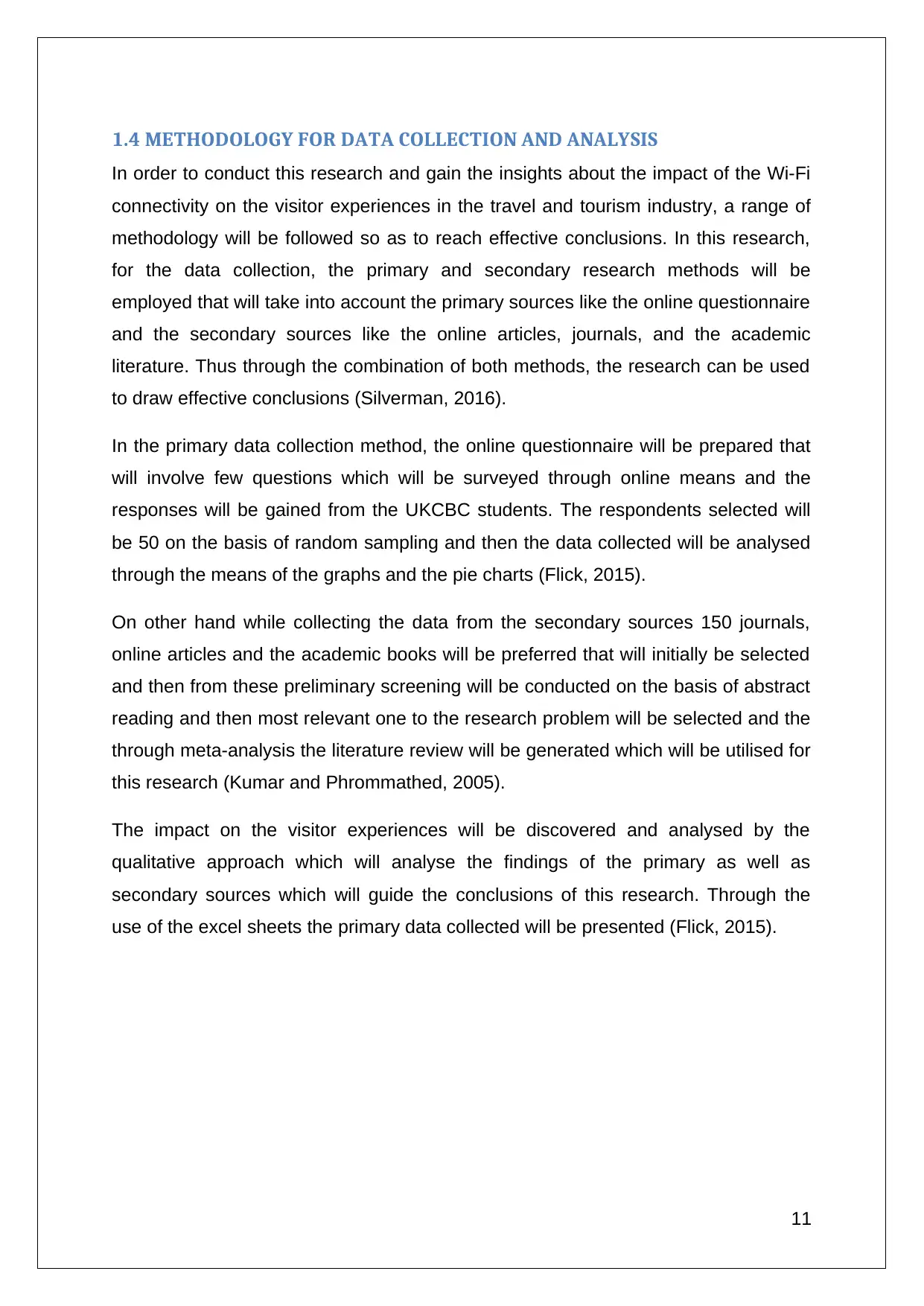
1.4 METHODOLOGY FOR DATA COLLECTION AND ANALYSIS
In order to conduct this research and gain the insights about the impact of the Wi-Fi
connectivity on the visitor experiences in the travel and tourism industry, a range of
methodology will be followed so as to reach effective conclusions. In this research,
for the data collection, the primary and secondary research methods will be
employed that will take into account the primary sources like the online questionnaire
and the secondary sources like the online articles, journals, and the academic
literature. Thus through the combination of both methods, the research can be used
to draw effective conclusions (Silverman, 2016).
In the primary data collection method, the online questionnaire will be prepared that
will involve few questions which will be surveyed through online means and the
responses will be gained from the UKCBC students. The respondents selected will
be 50 on the basis of random sampling and then the data collected will be analysed
through the means of the graphs and the pie charts (Flick, 2015).
On other hand while collecting the data from the secondary sources 150 journals,
online articles and the academic books will be preferred that will initially be selected
and then from these preliminary screening will be conducted on the basis of abstract
reading and then most relevant one to the research problem will be selected and the
through meta-analysis the literature review will be generated which will be utilised for
this research (Kumar and Phrommathed, 2005).
The impact on the visitor experiences will be discovered and analysed by the
qualitative approach which will analyse the findings of the primary as well as
secondary sources which will guide the conclusions of this research. Through the
use of the excel sheets the primary data collected will be presented (Flick, 2015).
11
In order to conduct this research and gain the insights about the impact of the Wi-Fi
connectivity on the visitor experiences in the travel and tourism industry, a range of
methodology will be followed so as to reach effective conclusions. In this research,
for the data collection, the primary and secondary research methods will be
employed that will take into account the primary sources like the online questionnaire
and the secondary sources like the online articles, journals, and the academic
literature. Thus through the combination of both methods, the research can be used
to draw effective conclusions (Silverman, 2016).
In the primary data collection method, the online questionnaire will be prepared that
will involve few questions which will be surveyed through online means and the
responses will be gained from the UKCBC students. The respondents selected will
be 50 on the basis of random sampling and then the data collected will be analysed
through the means of the graphs and the pie charts (Flick, 2015).
On other hand while collecting the data from the secondary sources 150 journals,
online articles and the academic books will be preferred that will initially be selected
and then from these preliminary screening will be conducted on the basis of abstract
reading and then most relevant one to the research problem will be selected and the
through meta-analysis the literature review will be generated which will be utilised for
this research (Kumar and Phrommathed, 2005).
The impact on the visitor experiences will be discovered and analysed by the
qualitative approach which will analyse the findings of the primary as well as
secondary sources which will guide the conclusions of this research. Through the
use of the excel sheets the primary data collected will be presented (Flick, 2015).
11
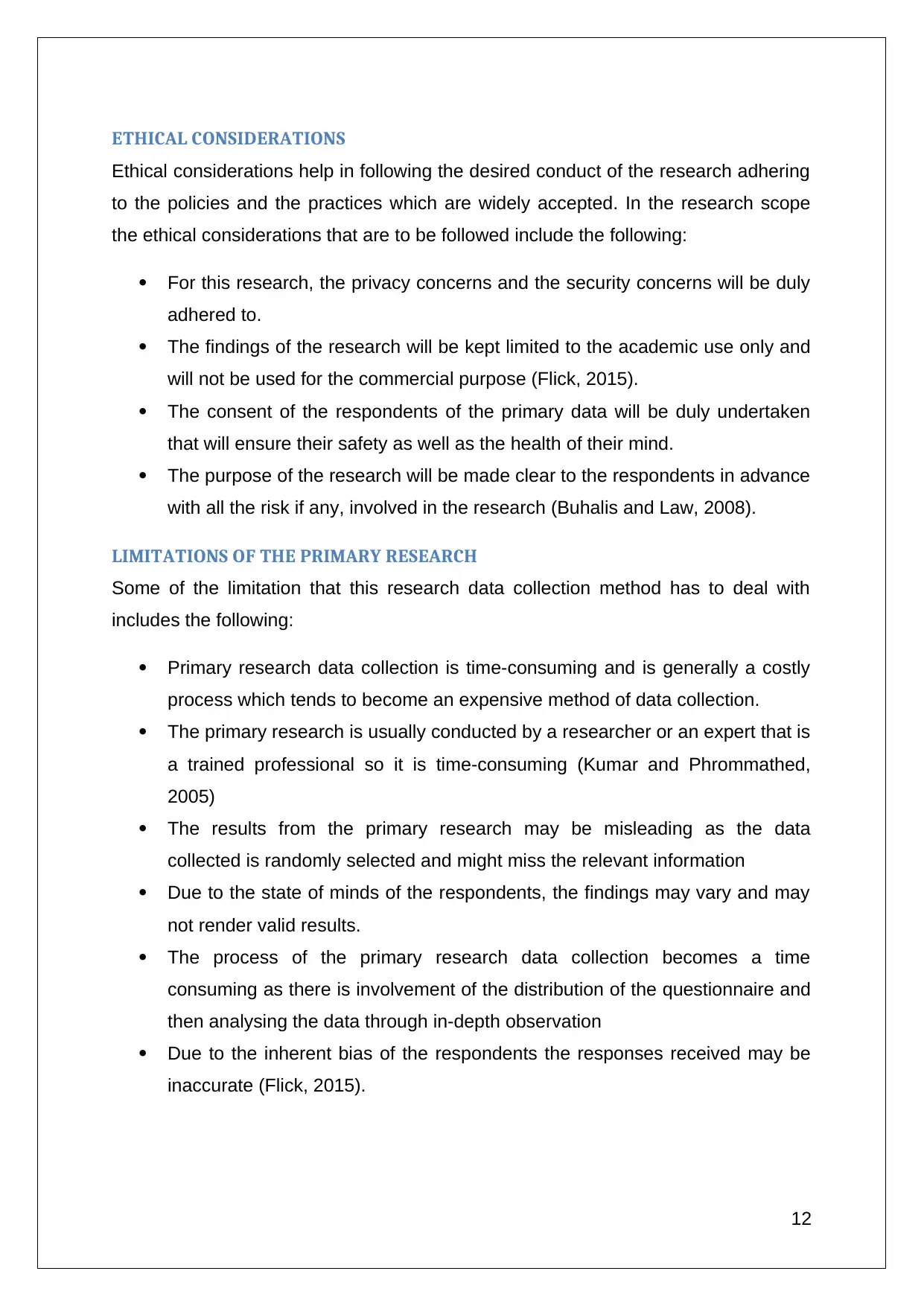
ETHICAL CONSIDERATIONS
Ethical considerations help in following the desired conduct of the research adhering
to the policies and the practices which are widely accepted. In the research scope
the ethical considerations that are to be followed include the following:
For this research, the privacy concerns and the security concerns will be duly
adhered to.
The findings of the research will be kept limited to the academic use only and
will not be used for the commercial purpose (Flick, 2015).
The consent of the respondents of the primary data will be duly undertaken
that will ensure their safety as well as the health of their mind.
The purpose of the research will be made clear to the respondents in advance
with all the risk if any, involved in the research (Buhalis and Law, 2008).
LIMITATIONS OF THE PRIMARY RESEARCH
Some of the limitation that this research data collection method has to deal with
includes the following:
Primary research data collection is time-consuming and is generally a costly
process which tends to become an expensive method of data collection.
The primary research is usually conducted by a researcher or an expert that is
a trained professional so it is time-consuming (Kumar and Phrommathed,
2005)
The results from the primary research may be misleading as the data
collected is randomly selected and might miss the relevant information
Due to the state of minds of the respondents, the findings may vary and may
not render valid results.
The process of the primary research data collection becomes a time
consuming as there is involvement of the distribution of the questionnaire and
then analysing the data through in-depth observation
Due to the inherent bias of the respondents the responses received may be
inaccurate (Flick, 2015).
12
Ethical considerations help in following the desired conduct of the research adhering
to the policies and the practices which are widely accepted. In the research scope
the ethical considerations that are to be followed include the following:
For this research, the privacy concerns and the security concerns will be duly
adhered to.
The findings of the research will be kept limited to the academic use only and
will not be used for the commercial purpose (Flick, 2015).
The consent of the respondents of the primary data will be duly undertaken
that will ensure their safety as well as the health of their mind.
The purpose of the research will be made clear to the respondents in advance
with all the risk if any, involved in the research (Buhalis and Law, 2008).
LIMITATIONS OF THE PRIMARY RESEARCH
Some of the limitation that this research data collection method has to deal with
includes the following:
Primary research data collection is time-consuming and is generally a costly
process which tends to become an expensive method of data collection.
The primary research is usually conducted by a researcher or an expert that is
a trained professional so it is time-consuming (Kumar and Phrommathed,
2005)
The results from the primary research may be misleading as the data
collected is randomly selected and might miss the relevant information
Due to the state of minds of the respondents, the findings may vary and may
not render valid results.
The process of the primary research data collection becomes a time
consuming as there is involvement of the distribution of the questionnaire and
then analysing the data through in-depth observation
Due to the inherent bias of the respondents the responses received may be
inaccurate (Flick, 2015).
12
⊘ This is a preview!⊘
Do you want full access?
Subscribe today to unlock all pages.

Trusted by 1+ million students worldwide
1 out of 39
Related Documents
Your All-in-One AI-Powered Toolkit for Academic Success.
+13062052269
info@desklib.com
Available 24*7 on WhatsApp / Email
![[object Object]](/_next/static/media/star-bottom.7253800d.svg)
Unlock your academic potential
Copyright © 2020–2025 A2Z Services. All Rights Reserved. Developed and managed by ZUCOL.





